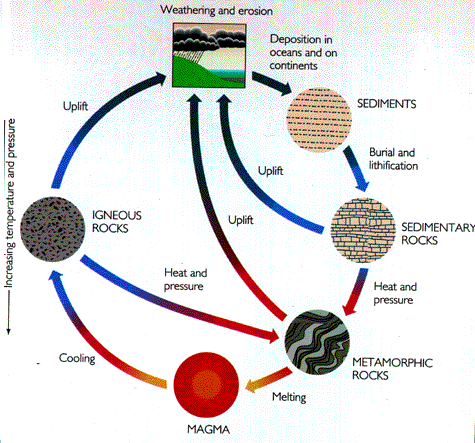Metamorphic Rocks
The process of metamorphism is one that changes or alters either the mineralogy or the texture, but typically both, of some pre-existing rock. Metamorphic rocks are consequently rocks that have undergone a change or "metamorphosis" from a previous state as a sedimentary, igneous or even another metamorphic rock. Owing to the fact that shales are the most abundant sedimentary rock (60% of all sediments), metamorphosed shales are abundant. The changes that take place are produced by chemical reactions between the minerals in the rock; it is a process that takes place entirely within the solid state (i.e., no melting occurs, as that would be an igneous process). The chemical reactions are largely driven by changes in temperature and pressure, and consequently as rocks become deeply buried, for example in a subduction zone, they are progressively subjected to higher pressures and temperatures resulting in metamorphism.
There are two primary types of metamorphism:
Regional Metamorphism occurs on a large scale, typically involving hundreds of square kilometers of surface area. It is the most widespread of the metamorphic types and is typical of the major fold-mountain belts such as the Appalachians, Himalayas, Alps or Rocky Mountains. The metamorphism results from deep burial typically associated with the crustal thickening that results from thrust faulting and folding associated with mountain building processes. As such it is a process that is usually associated with convergent plate tectonic boundaries. In this type of environment, folding and differential stress are common; consequently foliation is a common feature of regionally metamorphosed rocks.
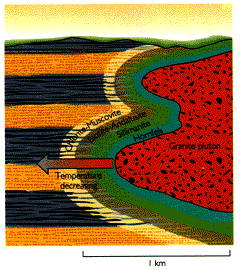
Contact Metamorphism is a local type of
metamorphism that develops at the "contact" of hot igneous intrusions and
the surrounding rocks into which they intrude. The contact metamorphism
is driven entirely by addition of heat into the surrounding rocks.
Consequently this type of metamorphism is also referred to as thermal
metamorphism. Metamorphism is typically restricted to a thin
"aureole" between 1 - 2 km wide adjacent to the pluton or batholith.
Since this environment is not associated with strong deformation, the metamorphic
rocks in contact aureoles usually do not exhibit foliation.
Metamorphic Textures
The single
most distinctive feature of regional metamorphic rocks that separates them
from both igneous and sedimentary rocks is the presence of a preferred
orientation of the individual minerals that comprise the rock.
The term used to describe a preferred orientation is foliation.
Foliation results from the 1) growth, 2) bending, or 3) rotation of minerals
into a parallel orientation. The minerals that are most likely to
produce foliation are those such as the micas (sheet-like) or elongated
minerals such as amphibole that are physically more stable in a particular
orientation relative to stress being placed on the rock. The figure
to the left illustrated that micas (green in this drawing) will tend to
grow with their flat sheets perpendicular to the maximum compressional
stress (arrows). This growth results in all the micas being oriented
parallel to each other, which produces the foliation. The lower image
is a photomicrograph (taken through a microscope) of a medium-grade metamorphosed
shale showing the parallel orientation of micas (blue and green in this
image). The yellow mineral is staurolite (image dimensions are approximately
2 x 3 mm).
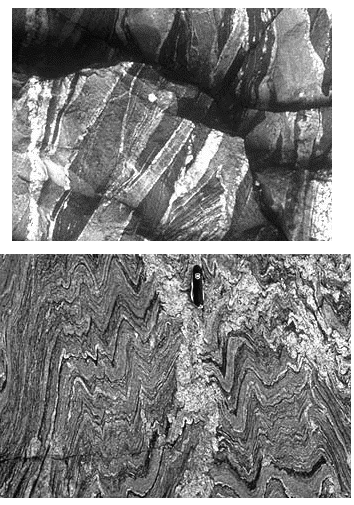 Another characteristic
texture that develops only at the very highest grades of metamorphism is
knows as segregation. The segregation typically involves the
physical and/or chemical movement of minerals into layers that concentrate
like minerals. This typically results in light and dark colored minerals
being concentrated in alternating layers. Rocks exhibiting metamorphic
segregation are called gneiss. The two images shown to the
left illustrate segregation typical of gneisses (digital images courtesy
of Martin Miller). The upper image, from the Skagit Gneiss from northern
Washington, shows the banding developed by segregation of light- and dark-colored
minerals. The lower image shows a typical gneiss with folding of
the individual segregations. Such extreme folding is typical of regional
metamorphic rocks in the major fold mountain belts.
Another characteristic
texture that develops only at the very highest grades of metamorphism is
knows as segregation. The segregation typically involves the
physical and/or chemical movement of minerals into layers that concentrate
like minerals. This typically results in light and dark colored minerals
being concentrated in alternating layers. Rocks exhibiting metamorphic
segregation are called gneiss. The two images shown to the
left illustrate segregation typical of gneisses (digital images courtesy
of Martin Miller). The upper image, from the Skagit Gneiss from northern
Washington, shows the banding developed by segregation of light- and dark-colored
minerals. The lower image shows a typical gneiss with folding of
the individual segregations. Such extreme folding is typical of regional
metamorphic rocks in the major fold mountain belts.
Classification of Metamorphic Rocks
Metamorphic rocks are named primarily on the basis of their textures
and grain size. It turns out that both texture and grain size are
functions of the degree, or grade of metamorphism. The grade
of metamorphism is primarily controlled by temperature. As temperature
increases, the grain size of the minerals in a metamorphic rock increases.
The most common names are derived from the metamorphism of shale. At low grades of metamorphism (typically around 300o C), one of the first chemical reactions to take place place converts clay minerals that formed during weathering, into micas such as muscovite (white mica) and chlorite (green mica). If these mica minerals grow during deformation, they will be aligned with their sheets perpendicular to the maximum compressive stress, thus imparting a foliation to the rock. At these low temperatures, however, the micas do not grow large enough to be seen with the naked eye. You can tell they are there because the rock brakes along the foliation planes. Such a low-grade metamorphic rock exhibiting a foliation, but with minerals too small to be seen with the naked eye is called slate. At higher grades of metamorphism, typically in the temperature range of 400 to 600o C, the micas grow large enough to be clearly visible to the naked eye, and consequently the foliation becomes obvious. These rocks are know as schist. At the very highest grades of metamorphism, typically with temperatures near or above 700o C, metamorphic segregation occurs, and produces rocks known as gneiss (see images above). Adjectives may be applied to these general rock names to indicate either major minerals present or parent material. Some common examples include the following: biotite schist, garnet-staurolite schist, sillimanite schist, granitic gneiss, mafic gneiss, etc.
The minerals that develop in a metamorphic rock depend upon:
- 1) the grade of metamorphism
2) the composition of the parent material
|
|
|
High-Grade Gneiss |
| chlorite --> biotite--> | garnet --> staurolite --> kyanite--> | sillimanite |
Many different minerals are found in metamorphosed shales because they are so chemically reactive and undergo a variety of chemical reactions with changing temperature.
In contrast, the metamorphism of quartz sandstone is not very exciting
because the parent material contains no other minerals which might react
with quartz to produce new metamorphic minerals. The table below
gives the minerals and rock name for some other common metamorphic parent
material.
|
|
|
|
| Sandstone | quartz +/- feldspar | quartzite |
| Limestone | calcite +/- dolomite | marble |
| Basalt | amphibole + plagioclase | (see below) |
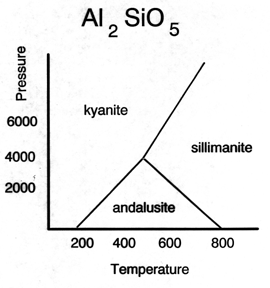 A simple example
of the kinds of chemical reactions which take place during metamorphism
is illustrated by the one-component chemical system Al2 SiO5
shown to the right. This system consists of three minerals, kyanite,
andalusite and sillimanite. Each of these minerals has the same chemical
composition (Al2 SiO5 ), but they differ in crystal
structure. So just like graphite and diamond, they are called polymorphs.
This phase diagram shows that each of the minerals is stable over a particular
range of temperature. Andalusite, for example, can only form at pressures
below the "triple point" (the unique point where the three reaction boundaries
intersect at ca., 4000 atms), and sillimanite can only form at temperatures
above the triple point (ca., 500o C). Note that progressive
metamorphism at pressures less than that of the triple point of a rock
composed of Al2 SiO5 would first produce kyanite,
then andalusite and finally sillimanite. Also note that the transition
from a kyanite rock to an andalusite rock would be seen in the field as
an andalusite isograd, and the transition from an andalusite rock
to a sillimanite rock would be a sillimanite isograd. This
diagram shows that mineral assemblages observed in metamorphic rocks may
be used to estimate the pressure and temperature at which the rock formed.
A simple example
of the kinds of chemical reactions which take place during metamorphism
is illustrated by the one-component chemical system Al2 SiO5
shown to the right. This system consists of three minerals, kyanite,
andalusite and sillimanite. Each of these minerals has the same chemical
composition (Al2 SiO5 ), but they differ in crystal
structure. So just like graphite and diamond, they are called polymorphs.
This phase diagram shows that each of the minerals is stable over a particular
range of temperature. Andalusite, for example, can only form at pressures
below the "triple point" (the unique point where the three reaction boundaries
intersect at ca., 4000 atms), and sillimanite can only form at temperatures
above the triple point (ca., 500o C). Note that progressive
metamorphism at pressures less than that of the triple point of a rock
composed of Al2 SiO5 would first produce kyanite,
then andalusite and finally sillimanite. Also note that the transition
from a kyanite rock to an andalusite rock would be seen in the field as
an andalusite isograd, and the transition from an andalusite rock
to a sillimanite rock would be a sillimanite isograd. This
diagram shows that mineral assemblages observed in metamorphic rocks may
be used to estimate the pressure and temperature at which the rock formed.
A useful example of how mineral stabilities can provide insight into both metamorphic and tectonic environments is the metamorphism of mafic (basaltic) rocks. Metamorphosed mafic rocks are simple mineralogically, typically consisting of amphibole, pyroxene and plagioclase feldspar. The amphiboles are important because different compositional types of amphibole are only stable under restricted ranges of pressure and temperature. The common types of amphibole, the conditions in which the amphibole is stable and the rock name are given below:
| Amphibole Type | Stability Range | Metamorphic Rock Name |
| green amphibole | low temperature and low pressure | Greenschist |
| black amphibole | medium temperature and pressure | Blackschist or "amphibolite" |
| blue amphibole | low temperature and high pressure | Blueschist |
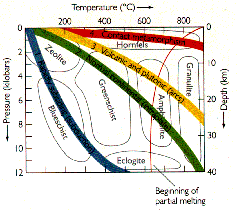 Blue amphiboles
are particularly important because the combination of low temperature and
high pressure is only achieved in subduction-zone environments. Recall
that heat flow over subduction zones is low and geothermal gradients correspond
to about 10o C/km. As shown in the figure to the right,
blueschists only form in the subduction zone environment. Consequently
recognition of old blueschists within continental interiors is a clue to
the former existence of a subduction zone. Greenschists, in contrast
form in the lower-grade portions of regional metamorphic belts associated
with normal continental geotherms. Amphibolites correspond to the
medium- to high-grade portion of normal geothermal gradients.
Blue amphiboles
are particularly important because the combination of low temperature and
high pressure is only achieved in subduction-zone environments. Recall
that heat flow over subduction zones is low and geothermal gradients correspond
to about 10o C/km. As shown in the figure to the right,
blueschists only form in the subduction zone environment. Consequently
recognition of old blueschists within continental interiors is a clue to
the former existence of a subduction zone. Greenschists, in contrast
form in the lower-grade portions of regional metamorphic belts associated
with normal continental geotherms. Amphibolites correspond to the
medium- to high-grade portion of normal geothermal gradients.
The Transition from Metamorphism to Magmatism
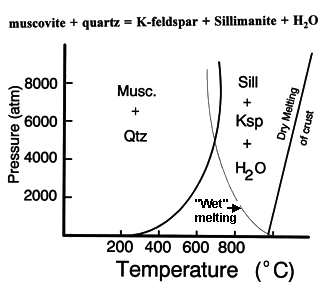 One of the most
important types of chemical reactions that takes place during metamorphism
is a so-called dehydration reaction. These reactions involve
hydrated (OH-bearing) minerals that react to form anhydrous minerals and
release H2O. One of the most important of these is a reaction
that only occurs at the very highest grades of metamorphism (typically
in the range of 700o C). It involves the breakdown of
white mica (muscovite) in the presence of quartz to produce K-feldspar,
sillimanite and H2O. Recall from our earlier discussion,
the normal continental geothermal gradient is not high enough to produce
melting of dry continental crust. However, if H2O is present,
the temperature required for melting is drastically lowered. The
diagram to the left shows the reaction boundary for the muscovite + quartz
breakdown, the "dry" melting boundary and the melting curve for "wet" melting.
Note that the metamorphic reaction intersects the wet melting curve at
temperatures of about 700o C and pressures of about 5000 atms.
Dry crust will not begin to melt at these conditions. However, if
metamorphic rocks undergo this reaction, H2O is released, fluxes
the crust and produces melting. This mechanism is responsible for
partial melting in the deep levels of the continental crust to produce
granitic magma.
One of the most
important types of chemical reactions that takes place during metamorphism
is a so-called dehydration reaction. These reactions involve
hydrated (OH-bearing) minerals that react to form anhydrous minerals and
release H2O. One of the most important of these is a reaction
that only occurs at the very highest grades of metamorphism (typically
in the range of 700o C). It involves the breakdown of
white mica (muscovite) in the presence of quartz to produce K-feldspar,
sillimanite and H2O. Recall from our earlier discussion,
the normal continental geothermal gradient is not high enough to produce
melting of dry continental crust. However, if H2O is present,
the temperature required for melting is drastically lowered. The
diagram to the left shows the reaction boundary for the muscovite + quartz
breakdown, the "dry" melting boundary and the melting curve for "wet" melting.
Note that the metamorphic reaction intersects the wet melting curve at
temperatures of about 700o C and pressures of about 5000 atms.
Dry crust will not begin to melt at these conditions. However, if
metamorphic rocks undergo this reaction, H2O is released, fluxes
the crust and produces melting. This mechanism is responsible for
partial melting in the deep levels of the continental crust to produce
granitic magma.
The Rock Cycle
Over the past several weeks, we have seen that Earth material can start
out as igneous rock, become weathered, eroded, transported and deposited
as sediment. This sediment can become lithified into sedimentary
rocks which can subsequently be metamorphosed. If metamorphism is
of sufficient intensity the rock can be melted and once again become an
igneous rock. The interrelationships of the various rock types and
the processes which relate the rock types to each other are shown in the
following diagram, known as the rock cycle, or rock recycle (yes,
Mother Nature recycles). The cycle is driven by both internal processes
(heat and convection) and external processes (weathering, transportation,
etc.), and will continue until the Earth cools sufficiently to no longer
have a dynamic interior.
